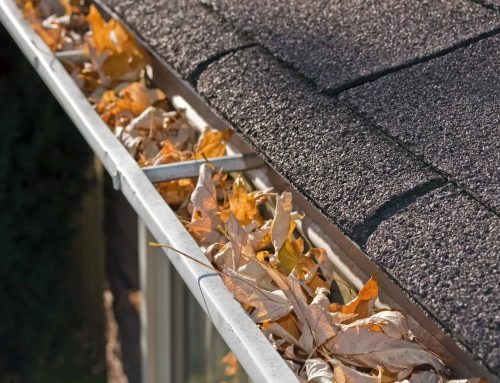You’re standing in your basement, staring at water stains on the wall or worse, actual puddles on the floor. Your first instinct might be to look for obvious culprits: cracked foundation walls, faulty plumbing, or poor waterproofing. But the real source of your basement moisture problems might be hiding in plain sight, twenty feet above your head. Your home’s eavestrough system, designed to protect your foundation by channeling water away from your house, could be the reason water is finding its way into your basement.
This connection between roof drainage and basement flooding isn’t immediately obvious to most homeowners, yet it’s one of the most common causes of foundation water issues. When eavestroughs fail to do their job properly, they don’t just create minor inconveniences—they can direct thousands of gallons of water directly toward your foundation, overwhelming your home’s drainage systems and finding every possible path into your basement.
Understanding this relationship between your gutters and basement moisture is crucial for Toronto area homeowners, where intense summer storms and rapid spring snowmelt can quickly expose weaknesses in your home’s water management systems. The good news is that eavestrough-related basement problems are often preventable and, in many cases, less expensive to fix than you might expect.
How Eavestroughs Protect Your Foundation
The Water Management System
Your home’s eavestrough system serves as the first line of defense in a comprehensive water management strategy. During a typical Toronto thunderstorm, a 1,500 square foot roof can collect over 900 gallons of water from just one inch of rainfall. Without proper gutters, this massive volume of water cascades directly off your roof edge, creating a concentrated deluge around your foundation perimeter.
Properly functioning eavestroughs capture this water and direct it through downspouts to areas where it can be safely dispersed away from your home’s foundation. The system works in conjunction with proper grading, foundation drainage, and landscaping to ensure water moves away from your house rather than pooling around it.
Foundation Vulnerability in Toronto Soil
Toronto’s clay-heavy soil presents unique challenges for foundation drainage. Clay soil has poor drainage characteristics, meaning water tends to sit rather than percolate away quickly. When large volumes of water are deposited near your foundation—either from malfunctioning gutters or inadequate drainage—the clay soil becomes saturated and can remain wet for extended periods.
This saturated soil creates hydrostatic pressure against foundation walls, forcing water through any available openings. Even microscopic cracks or imperfect mortar joints can become entry points when subjected to this persistent water pressure. The problem becomes worse during freeze-thaw cycles, as frozen water expands and can widen existing cracks.
The Domino Effect of Gutter Failure
When eavestroughs fail, they create a cascade of problems that can overwhelm your home’s other water management systems. Overflowing gutters deposit water in concentrated areas around your foundation, often exceeding the capacity of your foundation drainage system. Window wells can fill with water, weeping tiles can become overwhelmed, and even properly waterproofed basements can experience moisture infiltration when subjected to extreme water pressure.
The timing of gutter failure often coincides with when you need them most. Heavy rainfall events that expose gutter problems are the same storms that create the highest risk for basement flooding. This means homeowners often discover their eavestrough issues at the worst possible moment—during or immediately after a major storm.
Common Eavestrough Problems That Lead to Basement Issues
Clogged Gutters and Downspouts
Debris accumulation represents the most common cause of eavestrough-related basement problems. Toronto’s abundant tree coverage means gutters face constant challenges from falling leaves, twigs, and organic matter. When gutters become clogged, water has nowhere to go but over the sides, typically right next to your foundation.
Downspout blockages can be particularly problematic because they prevent the entire eavestrough system from draining properly. A single blocked downspout can cause water to back up through the entire gutter run, creating overflow conditions along your home’s entire perimeter. Common blockage culprits include tennis balls, toys, bird nests, and compacted organic debris.
The problem becomes more severe during Toronto’s transitional seasons when temperature fluctuations can cause debris to freeze into solid blockages. Ice dams can prevent proper drainage even after temperatures rise above freezing, as the ice acts as a barrier preventing normal water flow.
Improper Slope and Installation Issues
Gutters must maintain proper slope toward downspouts to function effectively—typically one-quarter inch of slope per ten feet of gutter run. When gutters are installed with insufficient slope or when settling and thermal expansion alter the original slope, water pools in low areas rather than flowing toward downspouts.
These standing water areas become collection points for debris and can freeze during cold weather, creating permanent blockages. Even when not completely blocked, areas with poor drainage allow debris to accumulate more quickly, requiring more frequent maintenance and creating higher risk for overflow conditions.
Installation problems often become more apparent over time as thermal expansion and building settlement stress improperly supported systems. Gutters hung with inadequate fasteners or inappropriate spacing may sag under load, creating drainage problems that worsen with each weather event.
Damaged or Separated Joints
Gutter joints represent the weakest points in any eavestrough system, particularly in Toronto’s challenging climate. Temperature extremes cause materials to expand and contract, stressing joint connections and potentially causing separations. When joints fail, water escapes at concentrated points, often directly adjacent to foundation walls.
Joint failures can be subtle initially, with small drips that don’t seem problematic. However, these small leaks often worsen rapidly, and even minor joint failures can direct significant water volumes toward your foundation during heavy rainfall events. The concentrated nature of joint leaks means they can overwhelm localized drainage more quickly than general overflow conditions.
Caulk-only joint repairs often fail in Toronto’s climate due to temperature cycling and UV exposure. Professional joint repairs typically require mechanical fastening combined with appropriate sealants designed for exterior temperature extremes.
Inadequate Downspout Discharge
Many basement water problems result from downspouts that discharge too close to the foundation or into areas with poor drainage. Building codes typically require downspouts to discharge at least six feet from foundation walls, but older homes may not meet current standards, and modifications over time can compromise original drainage plans.
Downspout extensions that are too short, damaged, or missing entirely can concentrate water in areas where it can easily reach foundation walls. Flexible extensions that become disconnected or damaged during lawn maintenance are common problems, especially on properties where landscaping work occurs regularly.
Underground drainage connections present their own challenges. Clay tiles or drain pipes that become damaged, separated, or clogged can cause water to back up and overflow near foundation walls. Tree roots, settling, and freeze-thaw damage can compromise underground drainage systems over time.
Signs Your Eavestroughs Are Contributing to Basement Problems
Exterior Warning Signs
Visual inspection of your home’s exterior can reveal many eavestrough problems before they cause basement issues. Look for water stains on siding below gutters, which indicate overflow conditions. White chalky deposits on foundation walls often show where water has been running consistently, carrying minerals from concrete or masonry.
Erosion patterns around your foundation perimeter can indicate where water is concentrating due to gutter problems. Look for channels in soil, displaced mulch, or areas where grass or plants have been damaged by excessive water. These signs often appear first near downspout discharge areas or where gutters overflow regularly.
Examine your gutters for visible sagging, which indicates either structural problems or debris accumulation. Even minor sagging can create drainage issues that worsen over time. Check for rust stains, separated joints, or damaged sections that could allow water to escape inappropriately.
Interior Moisture Indicators
Basement moisture problems often develop gradually, with early warning signs appearing before major flooding occurs. Musty odors in your basement can indicate elevated humidity levels caused by moisture infiltration. This moisture often results from minor but persistent water entry that may be related to eavestrough problems.
Efflorescence—white, chalky deposits on basement walls—indicates water movement through masonry or concrete. While this doesn’t always indicate active leaks, it shows that moisture is present and moving through your foundation materials. When combined with exterior signs of gutter problems, efflorescence can help confirm the connection.
Condensation on basement walls, pipes, or other surfaces may indicate elevated humidity levels from moisture infiltration. During Toronto’s humid summers, basement humidity problems often become more apparent, revealing moisture entry that occurs year-round but becomes problematic only under certain conditions.
Timing and Pattern Recognition
Pay attention to when basement moisture problems occur in relation to weather events. If basement issues appear during or shortly after heavy rainfall, particularly when combined with exterior signs of gutter overflow, the connection to eavestrough problems becomes more likely.
Seasonal patterns can also provide clues. Basement moisture that appears during spring snowmelt, after leaf-fall in autumn, or following ice storms may indicate gutter-related problems that become worse during specific weather conditions. Keep a log of when problems occur and what weather preceded them to help identify patterns.
Problems that occur during moderate rainfall suggest more severe eavestrough issues than those that only appear during extreme weather events. If your basement experiences moisture during typical Toronto summer thunderstorms, your gutters may have significant capacity or drainage problems requiring immediate attention.
Professional Assessment and Solutions
When to Call Professionals
While homeowners can identify many eavestrough problems through careful observation, professional assessment provides valuable expertise in understanding the complete picture. Contractors experienced with Toronto area drainage challenges can identify subtle problems that may not be obvious to homeowners and can assess whether observed problems are likely to cause basement issues.
Professional assessment becomes particularly important when basement moisture problems have already occurred. Determining whether eavestroughs are the primary cause, a contributing factor, or unrelated to basement issues requires understanding the complete drainage picture around your home. This assessment helps prioritize repairs and avoid spending money on solutions that won’t address the actual problem.
Complex situations involving multiple drainage issues, structural concerns, or recurring problems despite apparent repairs often benefit from professional evaluation. Experienced contractors can identify interactions between different systems and recommend comprehensive solutions rather than piecemeal repairs.
Diagnostic Techniques
Professional contractors use various methods to assess eavestrough performance and its relationship to basement moisture problems. Water testing involves running measured volumes of water through gutter systems to identify capacity limitations, blockages, and overflow patterns. This testing can reveal problems that aren’t apparent during visual inspection.
Slope measurement using specialized tools can identify drainage problems that aren’t visible to the eye. Even small deviations from proper slope can cause significant drainage issues, particularly in longer gutter runs. Professional assessment can determine whether observed problems require complete system replacement or targeted repairs.
Underground drainage assessment may involve camera inspection of drain tiles or downspout connections to identify blockages, damage, or inadequate capacity. This technology can locate problems without excavation and help determine the most cost-effective repair approaches.
Comprehensive Repair Strategies
Professional repair strategies address not just immediate eavestrough problems but also the broader drainage issues that contribute to basement moisture. This might include upgrading downspout discharge systems, improving surface drainage around foundations, or coordinating eavestrough repairs with other waterproofing improvements.
System upgrades during repairs can improve long-term performance and reduce future maintenance requirements. This might include installing larger capacity gutters for homes in areas prone to intense rainfall, adding downspouts to improve drainage, or incorporating gutter guards to reduce debris accumulation.
Professional repairs typically include warranties and follow-up service to ensure problems are resolved effectively. This ongoing relationship can be valuable for maintaining optimal drainage performance and addressing any issues that develop after initial repairs.
Protecting Your Home from Water Damage
Basement moisture problems can cause significant damage to your home’s structure, compromise indoor air quality, and create health hazards from mold growth. When these problems stem from eavestrough issues, they’re often preventable through proper maintenance and timely repairs. Understanding the connection between your roof drainage system and basement moisture empowers you to take proactive steps that protect your investment.
Regular eavestrough maintenance, prompt attention to developing problems, and professional assessment when issues are complex or recurring form the foundation of effective basement moisture prevention. Don’t wait for minor eavestrough problems to become major basement flooding—address drainage concerns before they compromise your home’s integrity.
Toronto’s challenging climate demands attention to detail in all aspects of home drainage, from gutters to foundation waterproofing. By maintaining your eavestrough system properly and understanding its role in your home’s overall water management, you can prevent many basement moisture problems and protect your home’s value and habitability.
If you’re experiencing basement moisture issues or have concerns about your eavestrough system’s performance, professional assessment can provide peace of mind and prevent costly damage. Ontario Downspout Service has helped thousands of GTA homeowners resolve drainage challenges and protect their homes from water damage. Our experience with Toronto area conditions and comprehensive approach to drainage solutions can help identify and resolve the connection between your gutters and basement moisture concerns.








